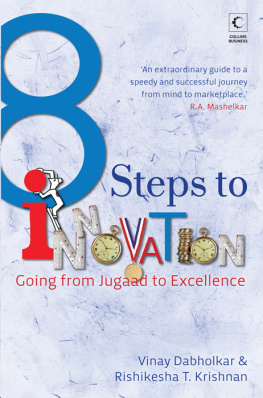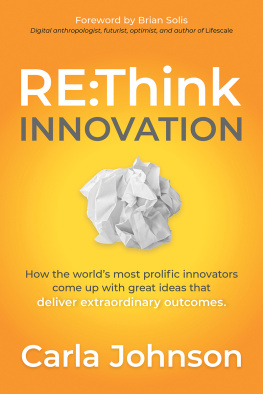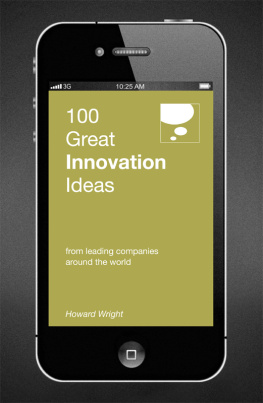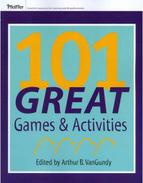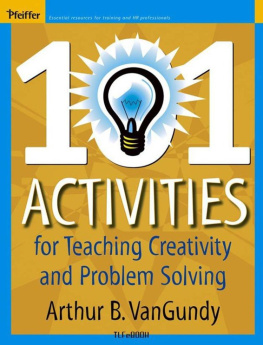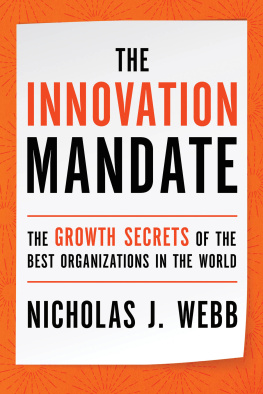VanGundy - Getting to innovation: how asking the right questions generates the great ideas your company needs
Here you can read online VanGundy - Getting to innovation: how asking the right questions generates the great ideas your company needs full text of the book (entire story) in english for free. Download pdf and epub, get meaning, cover and reviews about this ebook. City: New York;NY, year: 2007;2016, publisher: Amacom, genre: Business. Description of the work, (preface) as well as reviews are available. Best literature library LitArk.com created for fans of good reading and offers a wide selection of genres:
Romance novel
Science fiction
Adventure
Detective
Science
History
Home and family
Prose
Art
Politics
Computer
Non-fiction
Religion
Business
Children
Humor
Choose a favorite category and find really read worthwhile books. Enjoy immersion in the world of imagination, feel the emotions of the characters or learn something new for yourself, make an fascinating discovery.

Getting to innovation: how asking the right questions generates the great ideas your company needs: summary, description and annotation
We offer to read an annotation, description, summary or preface (depends on what the author of the book "Getting to innovation: how asking the right questions generates the great ideas your company needs" wrote himself). If you haven't found the necessary information about the book — write in the comments, we will try to find it.
VanGundy: author's other books
Who wrote Getting to innovation: how asking the right questions generates the great ideas your company needs? Find out the surname, the name of the author of the book and a list of all author's works by series.
Getting to innovation: how asking the right questions generates the great ideas your company needs — read online for free the complete book (whole text) full work
Below is the text of the book, divided by pages. System saving the place of the last page read, allows you to conveniently read the book "Getting to innovation: how asking the right questions generates the great ideas your company needs" online for free, without having to search again every time where you left off. Put a bookmark, and you can go to the page where you finished reading at any time.
Font size:
Interval:
Bookmark:
Getting to
INNOVATION
How Asking the Right Questions Generates
the Great Ideas Your Company Needs
Arthur B. VanGundy

To my daughters, Sarah and Laura,
and my granddaughter, Chloe,
and
in memory of my parents,
Arthur B. VanGundy, M.D.,
and Sarajane Miesse VanGundy
Anyone who has followed management trends for the past forty or so years knows that there always seems to be the so-called Next Big Thing. In the 1950s, basic brainstorming was the rage, with countless articles written about it, some good and some not so goodfor example, brainstorming is nothing more than cerebral popcorn! In the 1960s and early 1970s, sensitivity groups (or T-groups) were in vogue. Group leader gurus would lead groups of managers by not leading. That is, after some broad, brief opening remarks, they would silently sit there waiting for someone in the group to say something. After that, they mostly would just facilitate and try to clarify. Supposedly, the inner manager somehow would emerge. Again, more research would follow with inconclusive findings. The 1980s ushered in the age of the quality movement (although some would maintain it began earlier) with the implementation of quality control, quality circles, Kaizen, Six Sigma, and other related approaches for enhancing worker performance.
Although the quality movement still exists, the 1990s saw the beginnings of corporate innovation as the next it approach, emerging from components of the emphasis on quality. Innovation has hit the corporate world with a force unknown in previous generations of business trends; however, profit-driven organizations have not been alone. Globalization of technology, media, cultures, commerce, and the new economy have created a momentum to forge new directions with customers and clients. Managers in profit, nonprofit, government, military, or educational institutions all now face the unenviable task of innovating like never before. The call has gone out for new ideas, fresh perspectives, and unique approaches to resolving old problems. In addition to the need for institutionalizing innovation processes, all organizations must confront the realities of how to define the challenges they face.
As my experience and knowledge base have grown over the years, it has become clear to me that the major challenges affecting organizations are not always those involving a lack of creativity. Unlike some thirty years ago, when I first started in the field, there now are hundreds of methods for idea generation available in increasing numbers of books and especially on the Internet. There are more creativity and innovation courses, training seminars, conferences, and consultants than ever before. Although idea execution remains a fertile area for future research and application, an even more important part of the innovation process requires urgent action: framing organizational innovation challenges at the outset of a project.
To define an organizational innovation challenge is to frame it. Perceptual frames create meaning that guides behavior. The purpose of this book is to demonstrate the art of framing innovation challenges to help organizations chart the best innovation courses possible. It is not another book on how to do strategic planning or how to institutionalize innovation; rather, it emphasizes the process of crafting organizational innovation challenges and organizing and mapping them conceptually to enable organizations to act strategically. Strategy provides context for this book, but it is not the primary content.
This book is organized into two parts, both based on the creative problem-solving process developed by Alex Osborn and Sidney Parnes. The first part forms the core and looks at the essential elements involved in transforming organizations by using innovation challenges. It covers what is known as the fuzzy front end of the innovation process. The second part presents information on the middle and back end of innovation that involve, respectively, idea generation and implementation. These are activities to use after framing one or more challenges.
discusses how to:
View organizational innovation challenges in the context of strategy.
Involve stakeholders in generating multiple strategic perspectives using Q-banks (questions) and C-banks (challenges).
Use seven essential criteria to evaluate challenges.
Write positioning and rationale statements for each challenge.
Link together multiple objectives in priority frameworks.
Create visual, conceptual maps of these frameworks.
Plan and conduct organizational innovation challenges.
presents an overview of the concept of innovation framing and its importance in organizations. Specifically, the point is made that generating great ideas for the wrong challenge can be even worse than generating mediocre ideas for the right problem. Most successful organizations have learned to devote resources to reframing their challenges in order to align better with and achieve their strategic objectives. One way is to test assumptions about organizational objectives and decide what order in which to achieve challenges.
provides a look at how organizations should initiate innovation challenges by generating and answering questions. Q-banks are used to gather a large number of important questions about an organization to provide the context for innovation efforts. They also are designed to involve key stakeholders in the process by requesting questions and responses from a diverse population and providing all with feedback from the other participants. This is a planned effort involving strategic due diligencethat is, stakeholders are required to surface key assumptions they may be making and to test them for validity by comparing perceptions with each other. A list of more than one hundred sample questions is presented, involving areas such as core competencies, customers, the company as a brand, competitive positioning, markets, and overall goals.
provides an overview of the challenge bank (C-bank) process. C-banks build on the results of Q-banks. That is, they use stakeholder responses to the final Q-bank challenge(s) to generate a list of potential innovation challenge solutions. This process is similar to that of Q-banks, in that stakeholders also are involved in one or more roundsthe focus, instead, is on ideas and not challenges.
discusses how to write (frame) innovation challenge questions. Once an organization has done its due diligence and analyzed responses from the Q-bank and other sources, the results can be used to generate lists of potential innovation challenge questions. This chapter describes how to use this information to frame challenge questions so that they are best suited for productive idea generation. An important part of this chapter is a discussion of the seven criteria for effective challenges. The use of positioning elements also is described in terms of how they can position a challenge in the minds of those generating ideas. Numerous case studies are used to illustrate this process. Finally, this chapter presents more than one hundred preframed challenges, all of which can be applied directly to a variety of organizational strategic topics. They also can serve as examples for creating challenges for specific situations and are grouped by application areafor example, customers, products/services, branding/marketing, and human resources.
capitalizes on the fact that many people are visual thinkers who can understand complex relationships among conceptual variables better if they are presented graphically. This chapter describes how to draw manually or use computer software programs to create cognitive maps of innovation variables and their interrelationships. Step-by-step instructions are provided to guide the reader in creating these visual roadmaps of innovation challenges. Business examples also are used to illustrate how to map multiple challenges.
Next pageFont size:
Interval:
Bookmark:
Similar books «Getting to innovation: how asking the right questions generates the great ideas your company needs»
Look at similar books to Getting to innovation: how asking the right questions generates the great ideas your company needs. We have selected literature similar in name and meaning in the hope of providing readers with more options to find new, interesting, not yet read works.
Discussion, reviews of the book Getting to innovation: how asking the right questions generates the great ideas your company needs and just readers' own opinions. Leave your comments, write what you think about the work, its meaning or the main characters. Specify what exactly you liked and what you didn't like, and why you think so.


